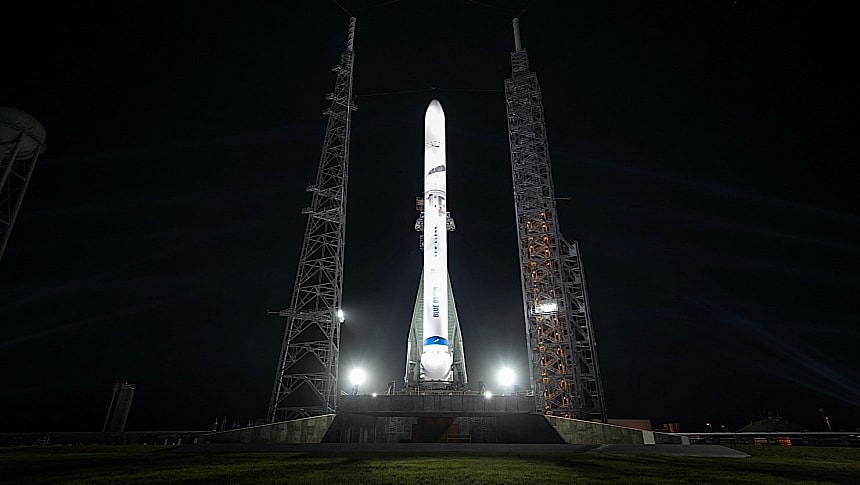After constantly making the headlines a couple of years back, Jeff Bezos' space company Blue Origin has entered a very deep cone of shadow, one that started in September 2022 and endures to this day.
On that faithful month Blue Origin launched the NS-23 mission, an uncrewed trip to Earth's orbit. At least that's what it should have been, as "a thermo-structural failure of the engine nozzle" caused the rocket to fail, effectively grounding the company's operations for more than a year now.
The rocket that was supposed to carry the mission's payloads to space was of the New Shepard variety, the same kind that conducted a series of crewed flights before the 2022 mishap.
But that's not the only rocket Blue Origin has in its arsenal. A second one, called New Glenn, was once deemed to be the rocket with the "most capable upper stage in the market." And it just stepped into the spotlight at Launch Complex 36 in Florida, giving the world the "first view of the advanced heavy-lift vehicle."
New Glenn is out on the pad, with no engines attached, as part of the upending procedures, one of the many tests to follow in the coming months. They are trials that do not require the presence of the rocket's source of power (which continues to be tested in Alabama and Texas): cryogenic fluid loading, pressure control, and venting.
Even if Blue Origin released just a single photo of the rocket on the pad, it looks simply impressive out there. Towering 320 feet (98 meters) above the ground, it comes with a fairing of 23 feet (seven meters) – and it has enough space inside to fit a total of three school buses.
A total of seven BE-4 engines will power the New Glenn. The powerplants are described as the most powerful liquid oxygen / liquefied natural gas (LOX/LNG) engines to be made since the Apollo era. And that's owed to the 550,000 pounds of thrust a single unit will be capable of generating.
The rocket's first stage will be reusable, and Blue Origin plans to fly a single rocket a minimum of 25 times before calling it a day. The returning boosters will land on a sea-based platform, not on land like the New Shepard is doing.
The first launch of the New Glenn rocket (named so after the first American to orbit our planet, John Glenn) is planned for later this year. If all goes well, Blue Origin will move to carry cargo to space for paying customers. And there are a few lined up already: NASA (first and foremost for the Escape and Plasma Acceleration and Dynamics Explorers mission, but also for the Artemis program), Amazon (for Project Kuiper), Telesat, and Eutelsat.
The rocket that was supposed to carry the mission's payloads to space was of the New Shepard variety, the same kind that conducted a series of crewed flights before the 2022 mishap.
But that's not the only rocket Blue Origin has in its arsenal. A second one, called New Glenn, was once deemed to be the rocket with the "most capable upper stage in the market." And it just stepped into the spotlight at Launch Complex 36 in Florida, giving the world the "first view of the advanced heavy-lift vehicle."
New Glenn is out on the pad, with no engines attached, as part of the upending procedures, one of the many tests to follow in the coming months. They are trials that do not require the presence of the rocket's source of power (which continues to be tested in Alabama and Texas): cryogenic fluid loading, pressure control, and venting.
Even if Blue Origin released just a single photo of the rocket on the pad, it looks simply impressive out there. Towering 320 feet (98 meters) above the ground, it comes with a fairing of 23 feet (seven meters) – and it has enough space inside to fit a total of three school buses.
A total of seven BE-4 engines will power the New Glenn. The powerplants are described as the most powerful liquid oxygen / liquefied natural gas (LOX/LNG) engines to be made since the Apollo era. And that's owed to the 550,000 pounds of thrust a single unit will be capable of generating.
The rocket's first stage will be reusable, and Blue Origin plans to fly a single rocket a minimum of 25 times before calling it a day. The returning boosters will land on a sea-based platform, not on land like the New Shepard is doing.
The first launch of the New Glenn rocket (named so after the first American to orbit our planet, John Glenn) is planned for later this year. If all goes well, Blue Origin will move to carry cargo to space for paying customers. And there are a few lined up already: NASA (first and foremost for the Escape and Plasma Acceleration and Dynamics Explorers mission, but also for the Artemis program), Amazon (for Project Kuiper), Telesat, and Eutelsat.









